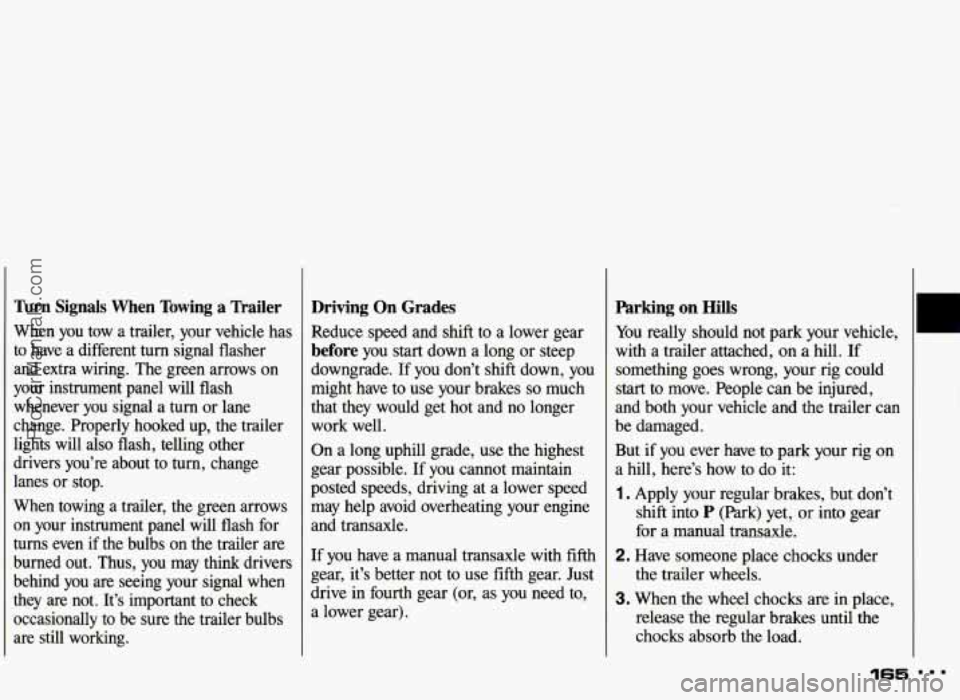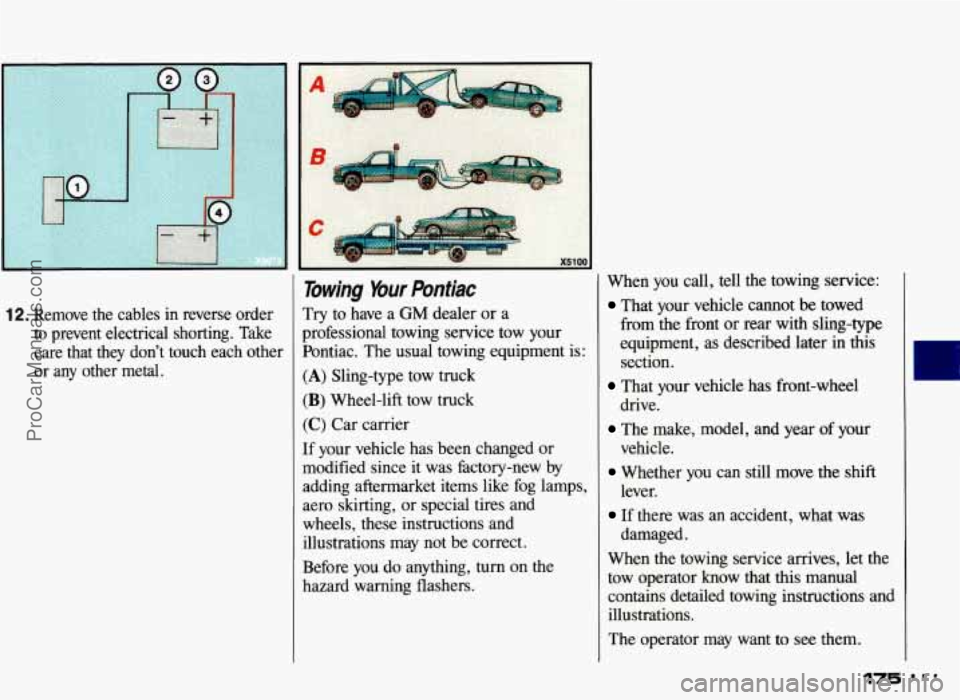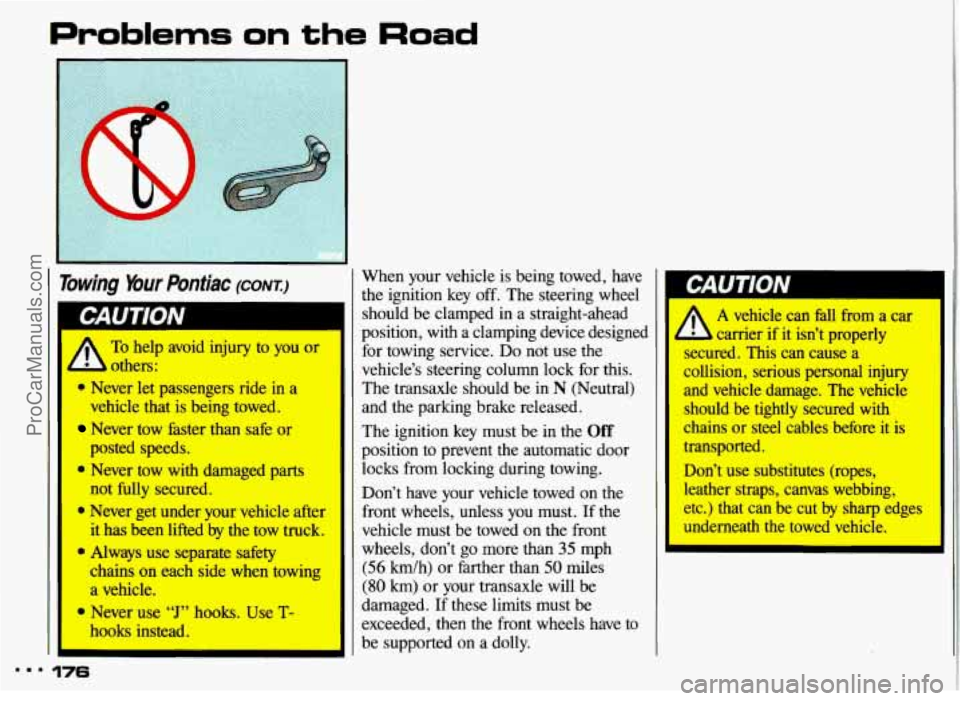Page 166 of 306

Turn Signals When Towing a ’Railer
When you tow a trailer, your vehicle has
to have a different turn signal flasher
and extra wiring. The green arrows on
your instrument panel will flash
whenever you signal a
turn or lane
change. Properly hooked up, the trailer
lights will also flash, telling other drivers you’re about to turn, change
lanes or stop.
When towing a trailer, the green arrows
on your instrument panel will flash for
turns even if the bulbs on the trailer are
burned out. Thus, you may think drivers
behind you are seeing your signal when
they are not. It’s important to check occasionally to be sure the trailer bulbs
are still working.
Driving On Grades
Reduce speed and shift to a lower gear
before you start down a long or steep
downgrade. If you don’t shift down, you
might have to use your brakes
so much
that they would get hot and no longer work well.
On a long uphill grade, use the highest
gear possible. If you cannot maintain
posted speeds, driving at a lower speed
may help avoid overheating your engine
and transaxle.
If you have a manual transaxle with
fifth
gear, it’s better not to use fifth gear. Just
drive in fourth gear (or, as you need to,
a lower gear).
Parking on Hills
You really should not park your vehicle,
with a trailer attached,
on a hill. If
something goes wrong, your rig could
start to move. People can be injured,
and both your vehicle and the trailer can
be damaged.
But if you ever have to park your rig on
a hill, here’s how to do it:
1. Apply your regular brakes, but don’t
shift into
P (Park) yet, or into gear
for a manual transaxle.
2. Have someone place chocks under
the trailer wheels.
3. When the wheel chocks are in place,
release the regular brakes until the chocks absorb the load.
165 DDD
ProCarManuals.com
Page 167 of 306

Your Driving and the Road
Driving with a mailer (CONT.)
4. Reapply the regular brakes. Then
apply your parking brake, and then shift to
P (Park), or R (Reverse) for a
manual transaxle.
5. Release the regular brakes.
When You Are Ready to Leave After
Parking on a
Hill
1. Apply your regular brakes and hold
the pedal down while you:
Start your engine;
Shift into a gear; and
Release the parking brake.
2. Let up on the brake pedal.
3. Drive slowly until the trailer is clear
4. Stop and have someone pick up and
of the chocks.
store the chocks.
Maintenance When Tmiler Towing
Your vehicle will need service more
often when you’re pulling a trailer. See
the Maintenance Schedule for more on
this. Things that are especially important in trailer operation are
automatic transaxle fluid (don’t overfiil),
engine oil, belts, cooling system, and
brake adjustment. Each
of these is
covered
in this manual, and the Ida
will help you find them quickly. If
you’re trailering, it’s a good idea to
review these sections before you
start
your trip.
Check periodically to see that all hitch
nuts and bolts are tight.
m.. 166
ProCarManuals.com
Page 170 of 306
Here you’ll find what to do about
some problems that can occur on
the road.
Problems on the Road
Hazard Warning Flashers .......................................... .170
Jumpstarting
.................................................... 17 1
TowingYourPontiac .............................................. 175
Engine Overheating
.............................................. .179
If a Tire Goes Flat ............................................... -185
Changing a Flat Tire
............................................. .186
CompactSpare
................................................... 192
If You’re Stuck: In Sand, Mud, Ice or Snow ........ ............ .193
169 ...
ProCarManuals.com
Page 176 of 306

12. Remove the cables in reverse order
to prevent electrical shorting. Take
care that they don't touch each other
or any other metal.
lowing %ur Pontiac
Try to have a GM dealer or a
professional towing service tow your
Pontiac. The usual towing equipment is:
(A) Sling-type tow truck
(B) Wheel-lift tow truck
(C) Car carrier
If your vehicle has been changed or
modified since it was hctory-new
by
adding aftermarket items like fog lamps,
aero
skirting, or special tires and
wheels, these instructions and illustrations may not be correct.
Before you do anything,
turn on the
hazard warning flashers. When
you call,
tell the towing service:
That your vehicle cannot be towed
fram the front or rear with sling-type
equipment, as described later
in this
section.
drive. vehicle.
lever. damaged.
That your vehicle has front-wheel
The make, model, and year of your
Whether you can still move the shift
If there was an accident, what was
When the towing service arrives, let the
tow operator know that
this manual
contains detailed towing instructions and
illustrations.
The operator may want to
see them.
175 I..
ProCarManuals.com
Page 177 of 306

Problems on the Road
Towing Your Pontiac (CONT.:)
A others:
To help avoid injury to you or
0 Never let passengers ride in a
vehicle that is being towed.
Never tow faster than safe or
0 Never tow with damaged parts I
posted speeds.
0 Always use separate safety
chains on each side when towing
a vehicle.
hooks instead.
9 Never use “J” hooks. Use T-
... 176
When your vehicle is being towed, have
the ignition key off. The steering wheel
should be clamped
in a straight-ahead
position, with a clamping device designed for towing service.
Do not use the
vehicle’s steering column lock for this.
The transaxle should be
in N (Neutral)
and the parking brake released.
The ignition key must be in the
Off
position to prevent the automatic door
locks from locking during towing.
--
not fully secured. Don’t have your vehicle towed on the
Never get under your vehicle after front wheels, unless you must. If the
it has been lifted by the tow truck. vehicle must be towed on the front
wheels, don’t go more than
35 mph
(56 km/h) or farther than 50 miles
(80 km) or your transaxle will be
damaged. If these limits must be
exceeded, then the front wheels have to
be supported
on a dolly.
‘I
I‘
W
I A vehicle can fall from a car
b carrier if it isn’t properly
secured. This can cause a
collision, serious personal injury
I and vehicle damage. The vehicle
should be tightly secured with
chains or steel cables before it is
transported.
Don’t use substitutes (ropes, leather straps, canvas webbing,
etc.) that can be cut by sharp edges
underneath the towed vehicle.
ProCarManuals.com
Page 179 of 306
Problems on the Road
X5086
Towing from the Rear-
Vehide
Hook-Up
Before hooking up to a tow truck, be
sure to read all the information in
Towing bur Pontiac earlier in this
section. Also be sure to use the proper
hook-up for your particular vehicle.
Do not tow with sling-type
equipment or rear bumper valance
will be damaged. Use wheel-lift or
car carrier equipment (additional
ramping may be required for car
carrier equipment). Use safetv
chains and wheel straps.
1-
I
178
When using wheel-lift equipment,
towing over rough surfaces can
I
damage a vehicle. To help avoid
this, install a towing dolly beneath the wheels that would otherwise be
on the ground during the tow. This
will increase clearance between the
wheel-lift equipment and the
underbody of the towed vehicle. Attach
a separate safety chain to each
side
of the axle inboard of the spring.
ProCarManuals.com
Page 195 of 306
Problems on the Road
If Mu’re Stuck: In Sand, Mud,
Ice or Snow (CONXI
Spinning your wheels can dest
parts
of your vehicle as well as
tires.
If you spin the wheels too
fast while shifting your transaxle
back and forth,
your transaxle.
__
OY
194
Rocking Your Vehicle to Get it Out:
First, turn your steering wheel left and
right. That will clear the area around
your front wheels. Then shift back and
forth between
R (Reverse) and a
forward gear, or with a manual
transaxle, between
1 or 2 and R (Reverse),
spinning the wheels as little as possible.
Release the accelerator pedal while you
shift, and press lightly on the
accelerator pedal when the transaxle is
in gear. If that doesn’t get you out after a
few tries, you may need to be towed out.
If you do need to be towed out, see the
Index under Towing Your Pontiac.
ProCarManuals.com
Page 264 of 306
I Schedule I
Is any one of these true for your vehicle?
Most trips are less than 4 miles (6 km).
Most trips are less than 10 miles (16 km) when outside
temperatures are below freezing.
The engine is at low speed most of the time (as in door-to-
door delivery, or
in stop-and-go traffic).
0 You operate your vehicle in dusty areas.
You tow a trailer. (With some models you shouldn’t ever
If any one (or more) of these is true for your driving, follow
tow
a trailer. See the
Idex under Towing a Trailer.)
Schedule I.
Schedule I/
Follow Schedule IT only if none of the above conditions is
true.
263
ProCarManuals.com